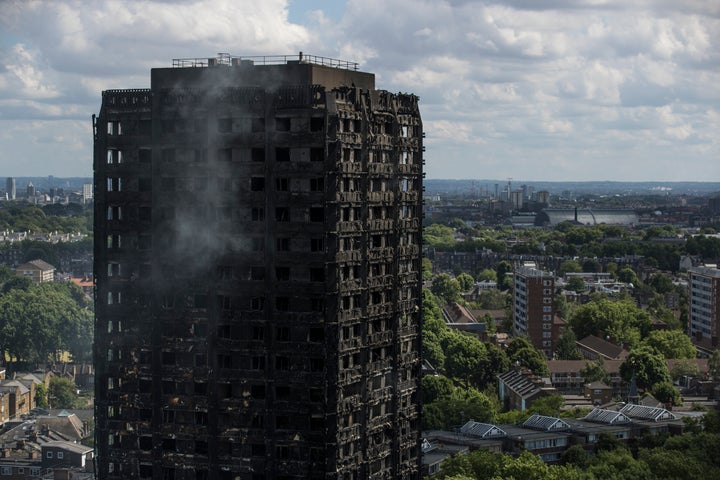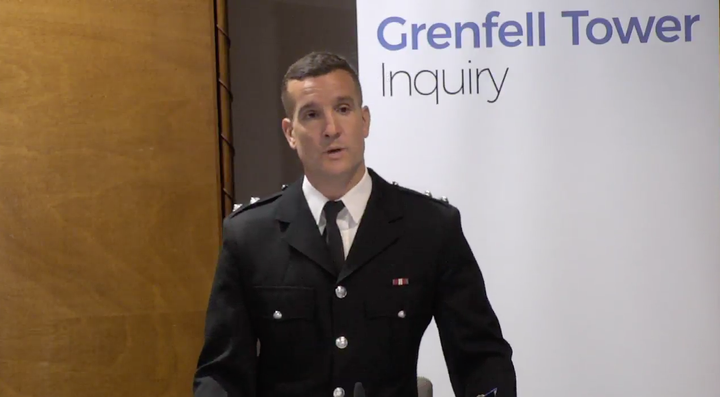
The first firefighter to tackle the Grenfell Tower blaze did not realise the block had cladding, the public inquiry into the tragedy heard on Tuesday.
The West London tower’s cladding has been highly controversial amid claims the flammable material helped hasten the spread of the fire.
The tragedy, which claimed 72 lives, led to cladding on high-rise buildings across the UK being checked and replaced, with the Government set to foot an estimated £400m bill for the work.
Michael Dowden, watch manager from North Kensington fire station, was the initial incident commander and told the hearing that he arrived at the scene to see an “orange glow” coming from a kitchen window on the fourth floor.
The inquiry’s top lawyer, Richard Millett QC, read him his statement from the night, saying: “It seemed contained within the compartment.”

Most high-rise blocks in the UK are designed so any fires are contained within the flat of origin – known as compartmentation – allowing a stay-put policy for other residents to be enforced.
But the flammable cladding installed around the tower fatally undermined this advice, as it allowed the blaze to engulf the structure within minutes.
Dowden and the first fire crew arrived just before 1am, around five minutes after the first emergency call at 12.54am. They were joined seconds later by another appliance.
Millett asked the fire officer whether he made any assumptions about whether the cladding system complied with building regulations, to which he replied: “Not at that moment in time, that is not for the dynamic stage for an incident commander.”
The lawyer continued: “Could you see that the exterior of the building was covered in a cladding envelope?”
Dowden said: “At that point I wasn’t aware it was cladding, at that point I thought it was the external part of Grenfell Tower.”
He added: “I would have looked at the outside but I wouldn’t have made any conscious note of what was on the outside, no.”
Dowden told the inquiry that he spoke to the man who lived in the burning flat – Behailu Kebede, from flat 16 – and was told the fire was in his kitchen on the fourth floor and no-one was still inside.
Asked if he was given any information to suggest it was “more than an ordinary kitchen fire”, he replied: “There was no information surrendered to think, apart from the information I gathered, that would suggest it was anything other than a compartment fire in a tower block.”
Dowden told the inquiry that he was wise to the danger of compartmentation failing when he arrived at the scene.
Pressed on his awareness of the risk, he said: “From memory, I would say yes, because my recollection is we had a covering jet on the external ready.
“Compartmentation does fail and that is something that is not uncommon in fires – weak points, windows, doors.
“Moving away from high-rise buildings, it is good practice to have a covering jet out, particularly to protect firefighters’ access and egress into a premise.
“We had a covering jet out because it was on the fourth floor, if it was higher up in the building that would have been more difficult to facilitate because of the limitation of fire-fighting jets, they would only reach a certain amount of floors.
“But because the fire was on the fourth floor, I believe we had a covering jet out ready in case compartmentation failed on the external of building.”
Dowden further told the inquiry that the “extremely dynamic” nature of the blaze’s early stages made it difficult for fire crews to maintain constant contact with the control room.
A Fire Lift Was Not Working - Did Not Comply With Regulations
The inquiry also heard that a fire lift at the tower was found to be not working soon after firefighters arrived, potentially exposing residents to “real risk”, Dowden said.
Crew manager Christopher Secrett – managing the “bridgehead”, or safe air space, two floors below the fire – radioed the news to his superior.
An expert report into the disaster by Dr Barbara Lane found the lifts did not appear to comply with building regulations.
Dowden said he “wasn’t aware at that time” the lift was not a full firefighting lift capable of transporting equipment and personnel or evacuating the building of casualties.
The fire brigade is supposed to be able to take control of a fire lift upon arrival at a high-rise tower – but this function did not work on June 14 last year.
Dowden said this failure could lead residents to use the lift, taking them into areas that were “compromised”.
Millett asked: “The consequences of the fire brigade not taking control of the lift can be serious?”
“It can be, yes,” the officer replied.
Asked about what could be done to mitigate this risk, he said: “Looking at it now, the only thing we could potentially do was isolate the power supply.”
Fire Crews Could Have Allowed Smoke To Leak Into The Stairwell
The inquiry was further told that fire crews could have allowed smoke to leak into the protected stairwell at the tower by running a hose from one floor to the other.
London Fire Brigade policy warns of this risk and says that hoses should not cause obstructions on the stairwell.
Dowden said he had been aware of this when a team of two firefighters took a hose from the third floor to the fourth, where the kitchen fire was located. A team was already located on the fourth floor tackling the blaze.
The dry rise system within Grenfell Tower was in the lobbies, not the stairwell, meaning two lobby doors would have to be propped open to allow hoses to be taken from one floor to the other.
Dowden said: “We can only work with what we are given on the night, in terms of what is given to use – we have to have a water supply, we have to put water on that fire.”
Asked if it was possible to plug in a hose on every individual floor that a fire is located instead, he replied: “That is almost impossible.”
The dry rise system used at Grenfell was not appropriate for a building so tall, the inquiry previously heard.
Building regulations advise the system – which requires the fire service to pump water from the ground through a hollow pipe – should not be used in buildings over 50 metres in height. Grenfell Tower was 67m tall.
Millett asked Dowden: “What would happen after you get above 50 metres?”
He replied: “The water supply would be almost non-existent.”
